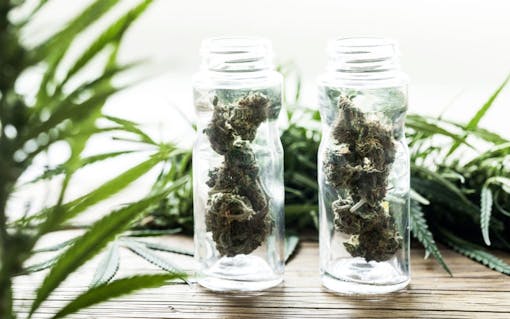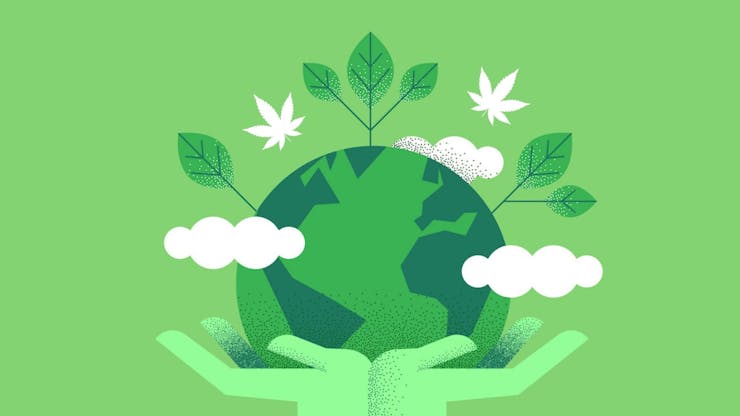When you think about contributing conditions to climate change and environmental decay, which sustainability issues come to mind first?
For most of us, the premier sustainability issues we think of are fossil fuels, deforestation, agriculture, and landfills. But you might be overlooking industries whose environmentally harmful practices are often shrouded in a cloud of smoke.
Namely, the cannabis industry.
Despite what marijuana’s many monikers (i.e. weed, grass, herb) might suggest, it still takes considerable effort to stay green while growing green. Cannabis’ demand for water, land, artificial lighting, and single-use packaging can leave a large environmental footprint if it isn’t done carefully.
Reduce high levels of waste due to strict regulation

A lack of eco-friendly regulations placed on legal marijuana is a huge reason for unsustainable cannabis cultivation and packaging practices.
For instance, few legal states allow for outdoor growing, a far more energy-efficient alternative to indoor growing. Many regulated markets mandate indoor cultivation of marijuana for “security” and “safety” reasons, but the downside is that more energy is needed to support this type of production.
In addition, strict requirements for childproofing and warning labels have led to increased use of single-use packaging, which contributes to plastic waste.
Luckily, things are changing in the cannabis industry for the better, and more eco-friendly alternatives are being explored nationwide. To see the large-scale impact, both growers and consumers alike need to educate themselves on the toll marijuana can have on the planet and what steps can be taken to offset the environmental impact.
Reduce energy consumption

In states where growers can’t legally grow cannabis outdoors, many are forced into a situation where they must squander energy to grow indoors.
Without access to the sun, indoor plants require energy-intensive grow lights. Plants need about 18 hours of light a day when in the vegetative stage and 12 hours a day when flowering, so electricity used to grow indoors quickly adds up. Not to mention the energy needed to power the fans, heating systems, air-conditioners, and dehumidifiers.
The majority of indoor growing methods require an exceptional amount of electricity or natural gas to operate. In fact, one study found that indoor marijuana cultivation consumes enough electricity to power 2 million average-sized U.S. homes, which is about 1% of all electricity used in the country.
Ultimately, the best way to help shrink the carbon footprint of the nation’s legal cannabis industry is to move weed production from indoor facilities to greenhouses and the great outdoors.
That being said, there are still steps indoor growers can take to be more sustainable like:
- Switching to LED grow lights to consume less energy, keep temperatures lower, and reduce water lost to evaporation
- Adopting solar and wind energy to fuel lighting technologies
- Using chilled water systems for dehumidification and cooling as opposed to traditional heat, ventilation, and air conditioning (HVAC) systems
Minimize water usage and chemical exposure
While outdoor growing is more energy-efficient, there are still some environmental downsides—namely water depletion and the use of pesticides.
Cannabis cultivation can be highly water-intensive. Large-scale cultivation of any crop, especially water-thirsty crops like marijuana, can often cause water depletion at alarmingly wasteful rates.
According to cannabis analytics firm New Frontier Data, legal and illicit cannabis crops used around 2.8 billion gallons of water in 2020, with that number predicted to nearly double by 2025.
In addition to excessive water usage, it’s always important to be mindful of hidden chemicals and pesticides involved in the products we are ingesting, no matter what industry we’re examining.
From a health and sustainability perspective, there are a few things that small and large producers can do to help keep consumers and the environment safe:
- Switch to more natural pesticides
- Use all-natural fertilizer
- Use aquifers to source pure water
- Collect rainwater to water the plants
- Utilize more eco-friendly extraction methods, such as CO2 extraction
De-emphasize the use of plastics

As we’ve explored, the cultivation of marijuana takes a heavy toll on the environment. But it doesn’t stop there. The way we package marijuana also plays a role in the cannabis industry’s environmental impact.
While it is important (and legally required) to provide consumers with child-proofed packaging and clear labeling, there’s a concerning amount of plastic waste because of it, contributing to an estimated 150 million tons of cannabis waste produced annually.
As the cannabis industry is becoming a bigger part of our living planet, the need for sustainable packaging solutions has never been greater.
Cannabis businesses and consumers can de-emphasize plastic use by:
- Investing in recycling initiatives, such as offering consumers a small discount for bringing in plastic containers that may be reused
- Opting for eco-friendly alternatives to plastic, such as bioplastics, recycled cardboard, glass, or hemp
- Composting on site
- Growing weed at home (if possible)
Support companies doing the work
Similar to food certifications such as USDA Organic and Fair Trade, the cannabis industry also needs ways to certify sustainable products.
Since 2004, Clean Green Certified has been inspecting and approving producers who use sustainable, natural, and organic practices, and providing the stamp of approval for brands putting in the hard work.
Conscious consumers can do their part to support these companies and cultivators by looking for companies with the Clean Green Certified seal and by supporting eco-minded brands in their area.
Know of other ways we can make the cannabis industry better for the environment? Let us know in the comments or on social media @Leafly on IG and Twitter.





